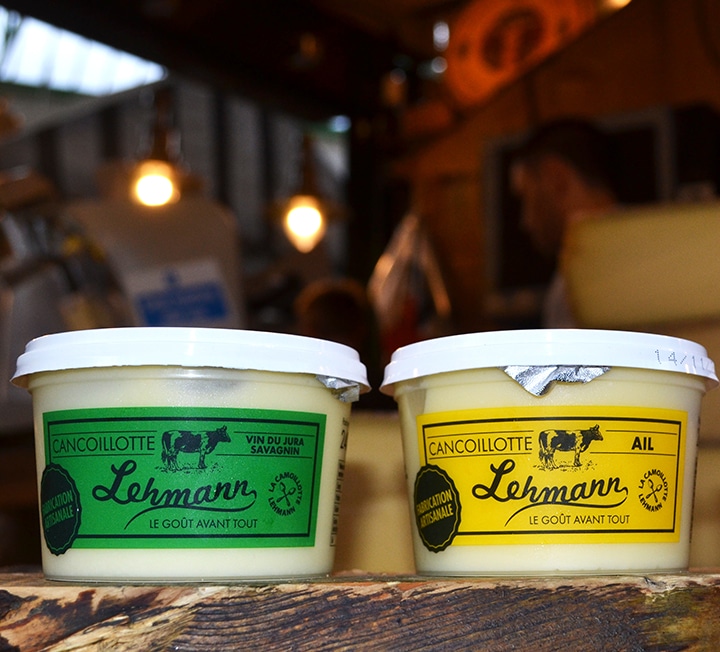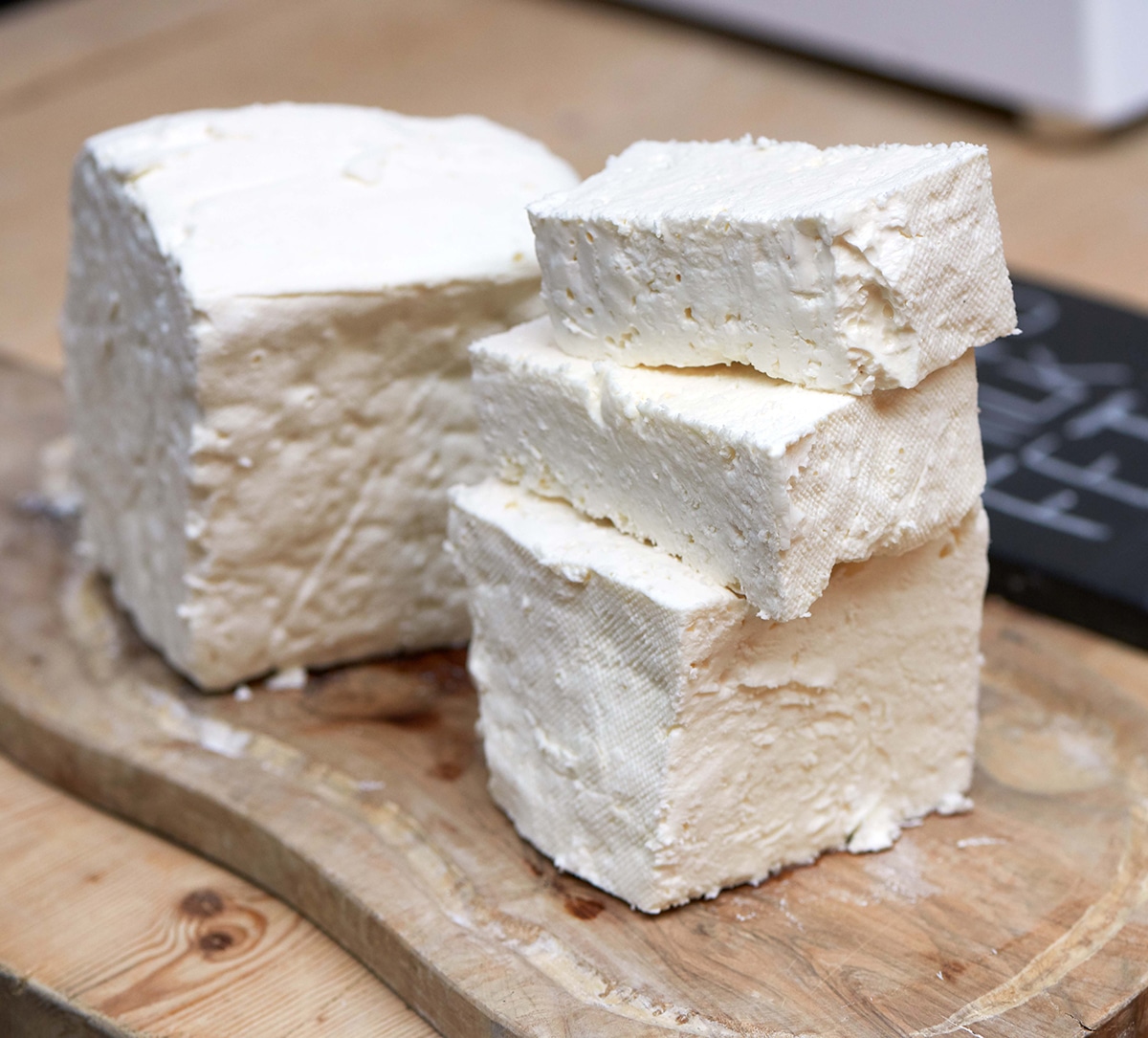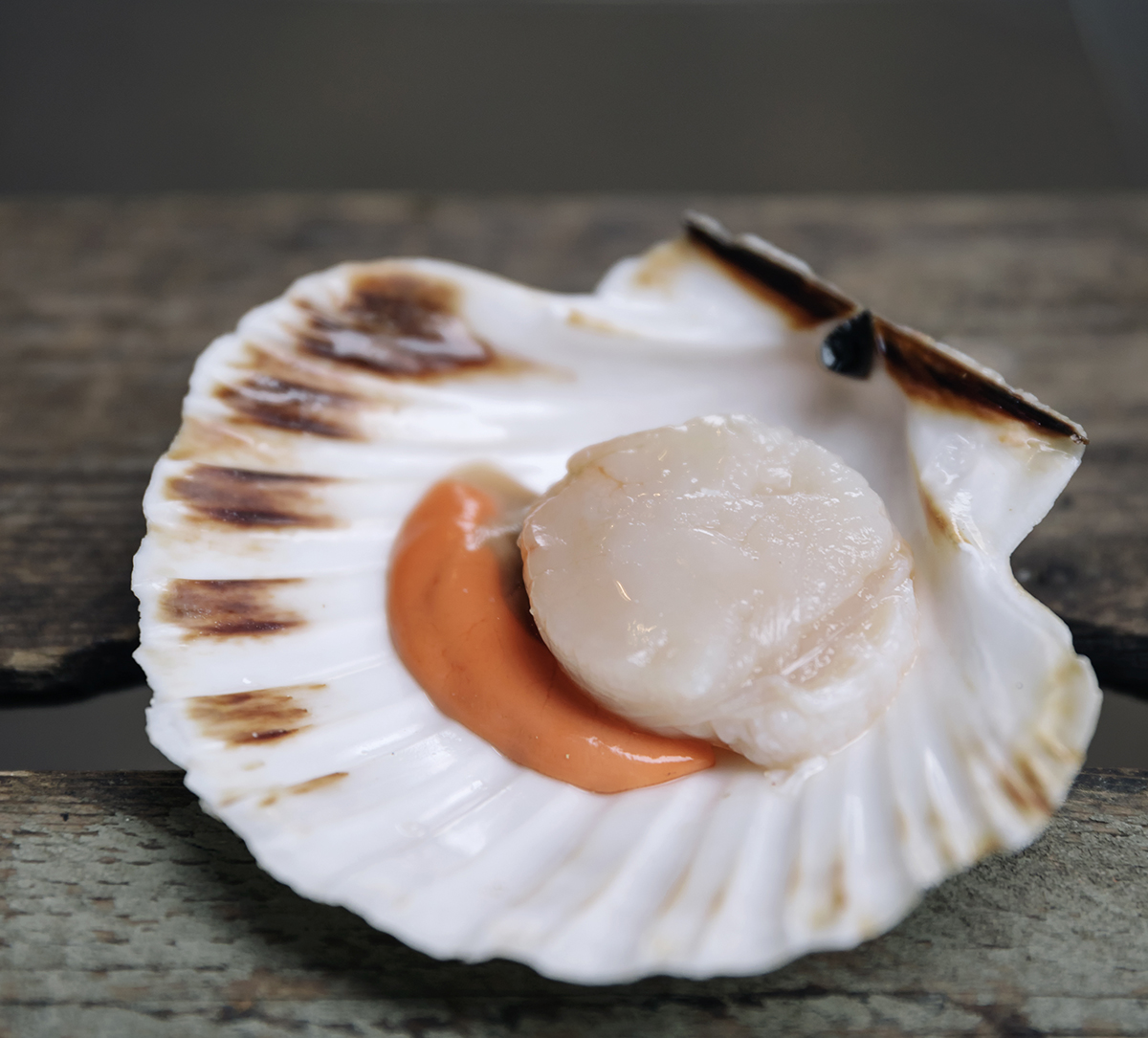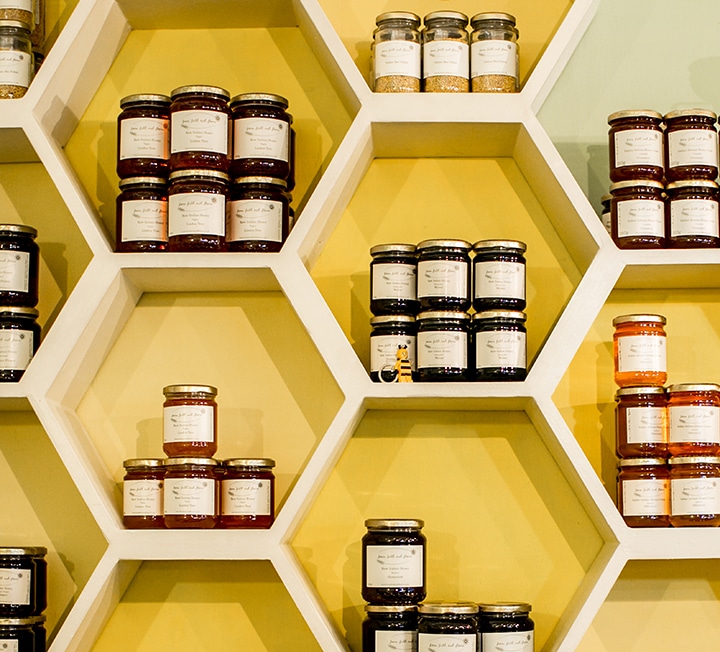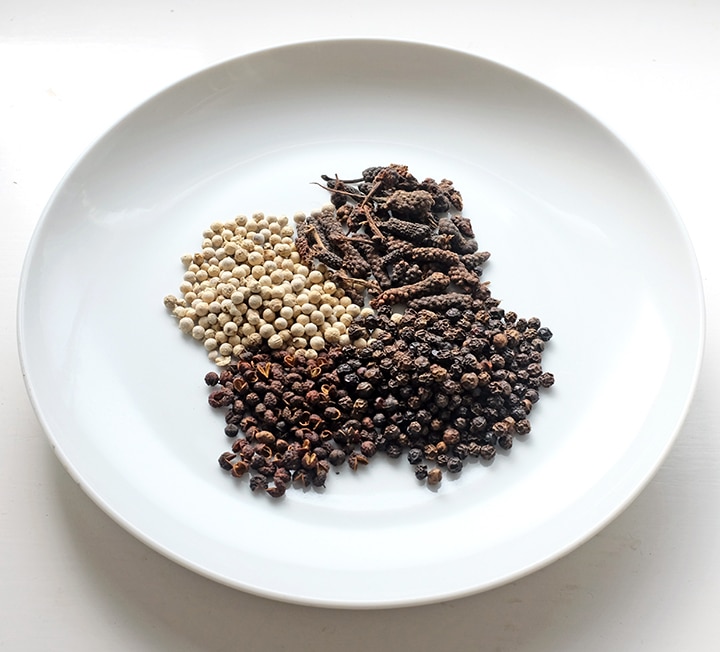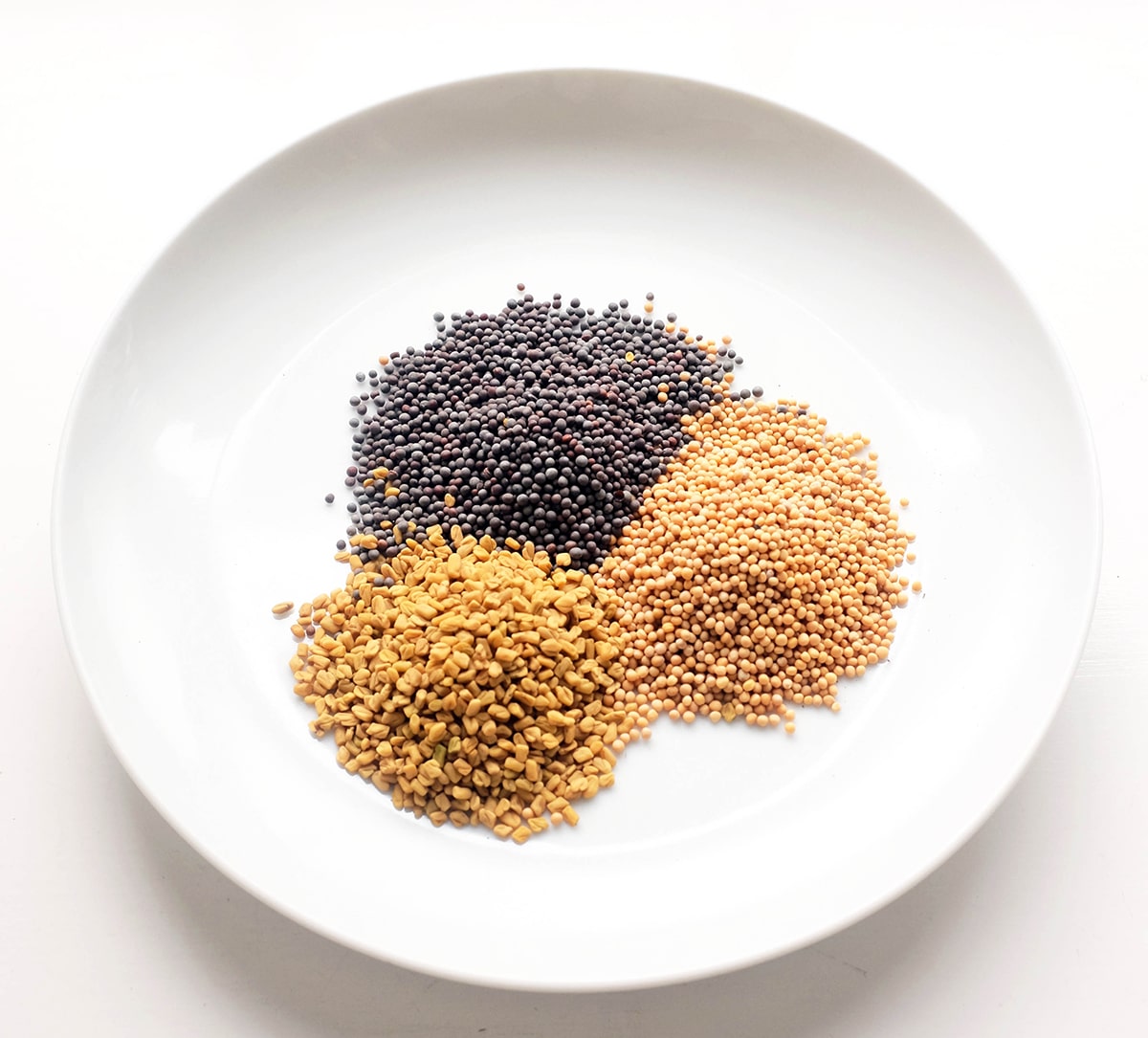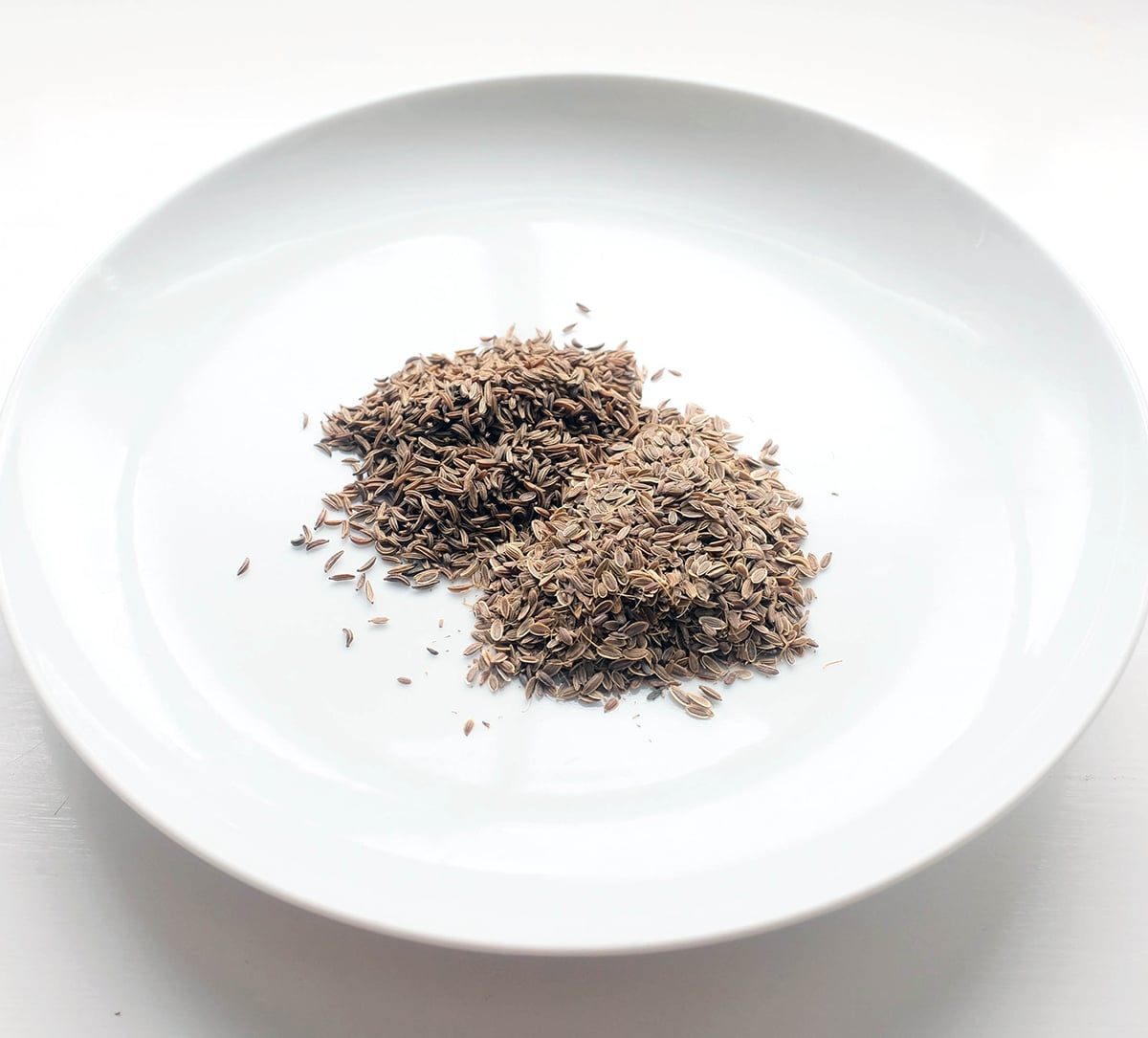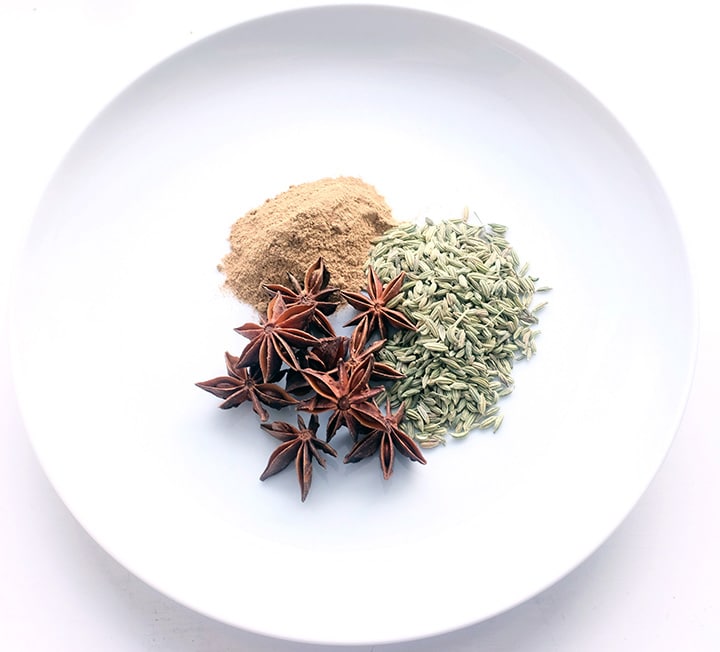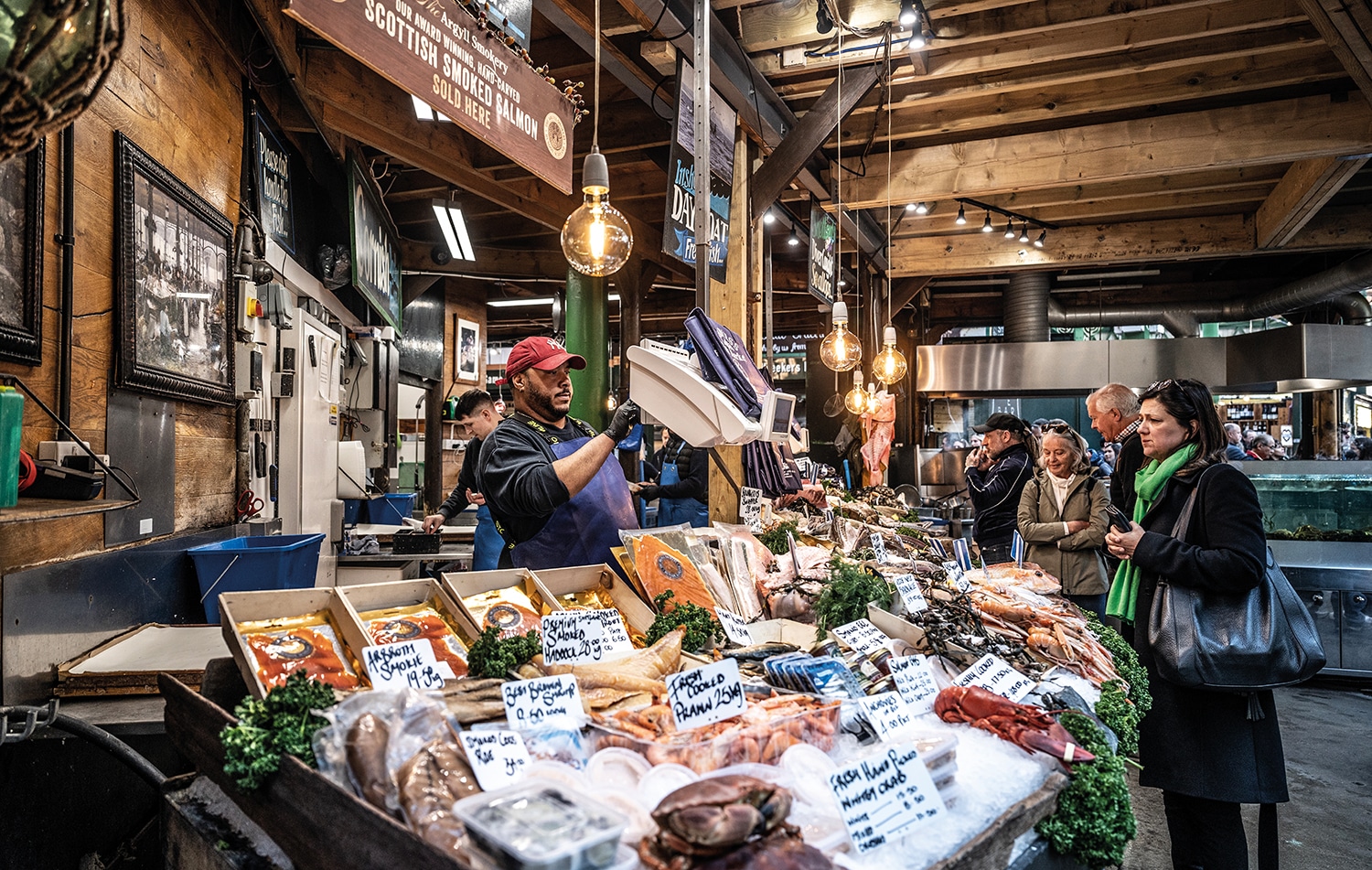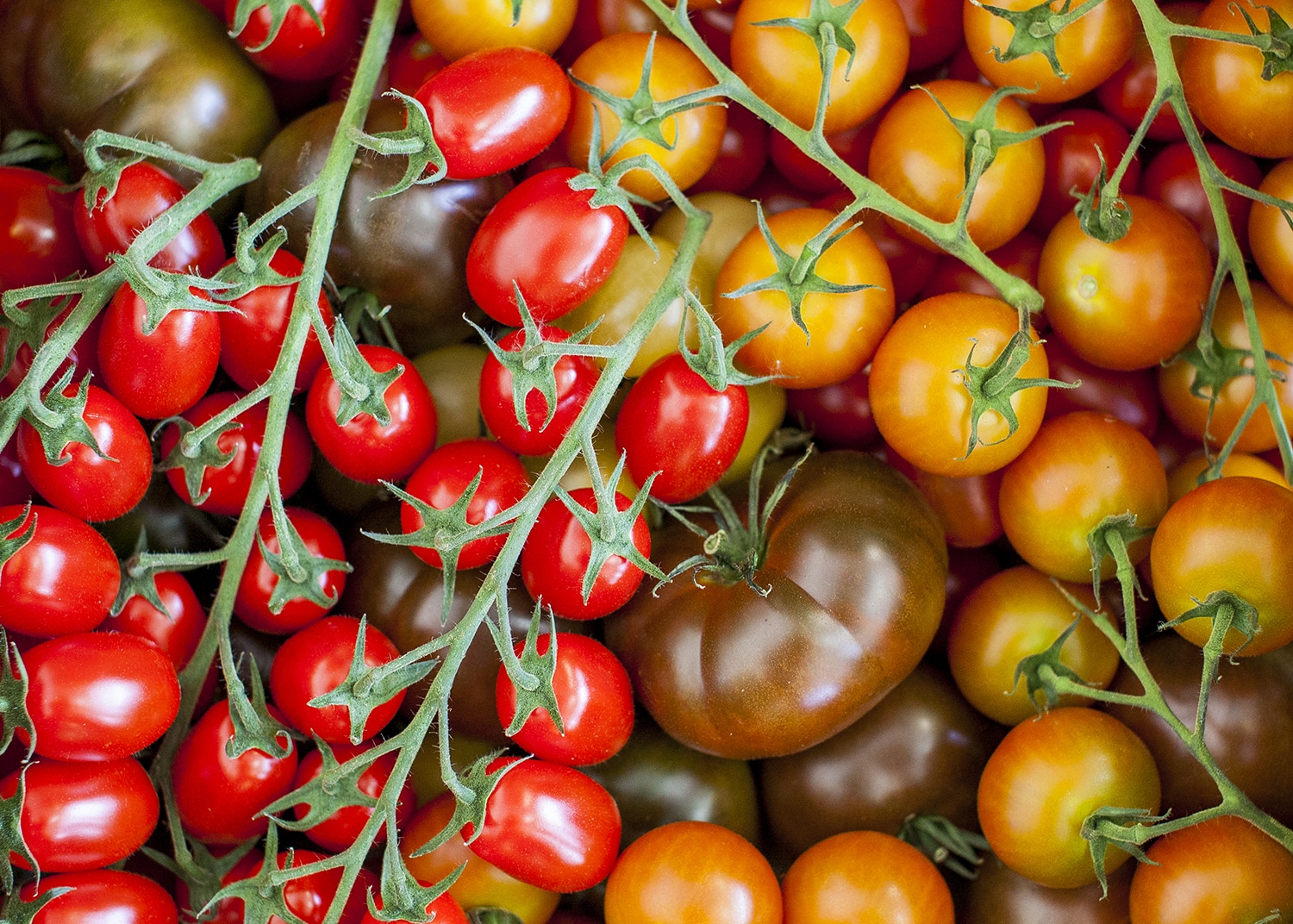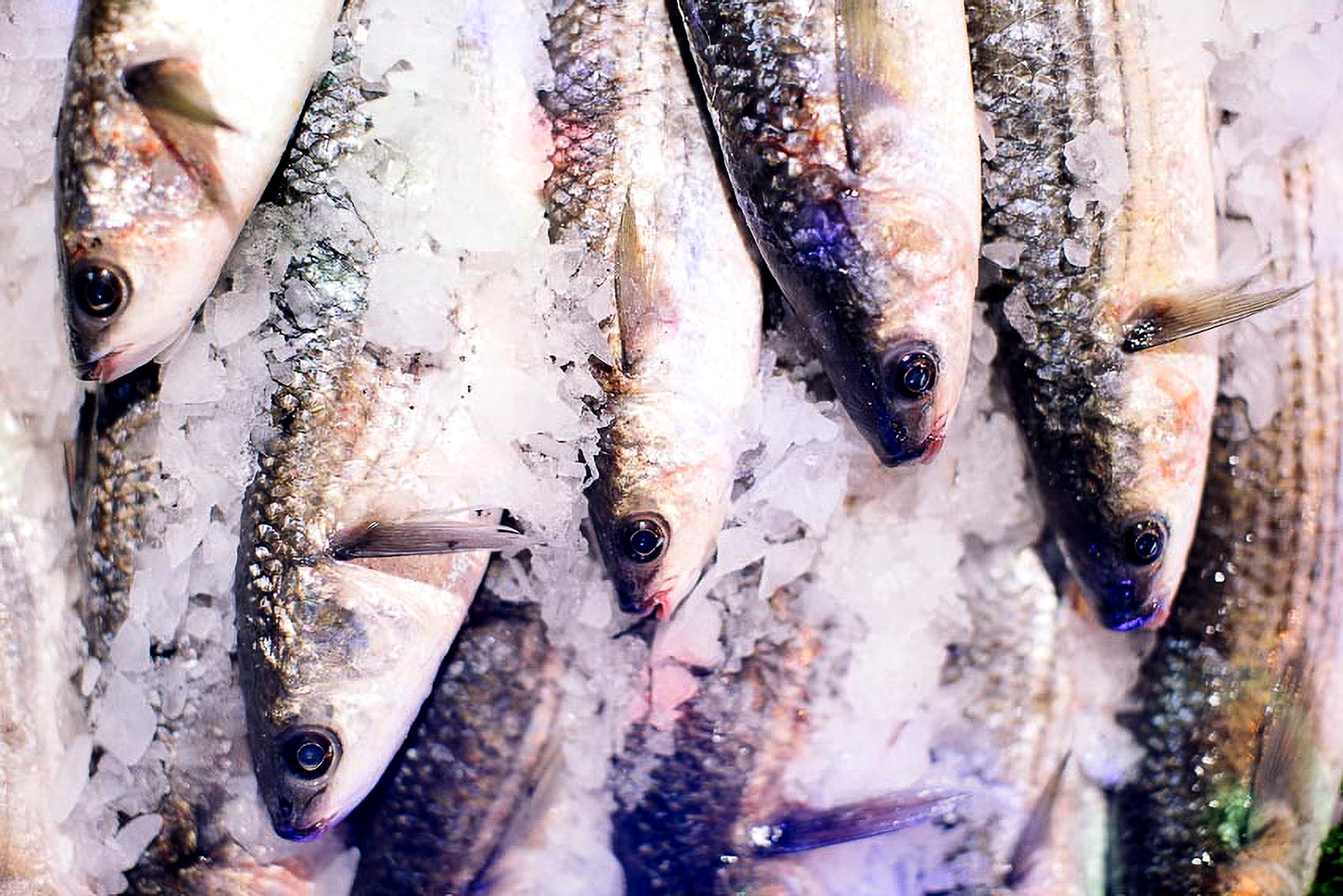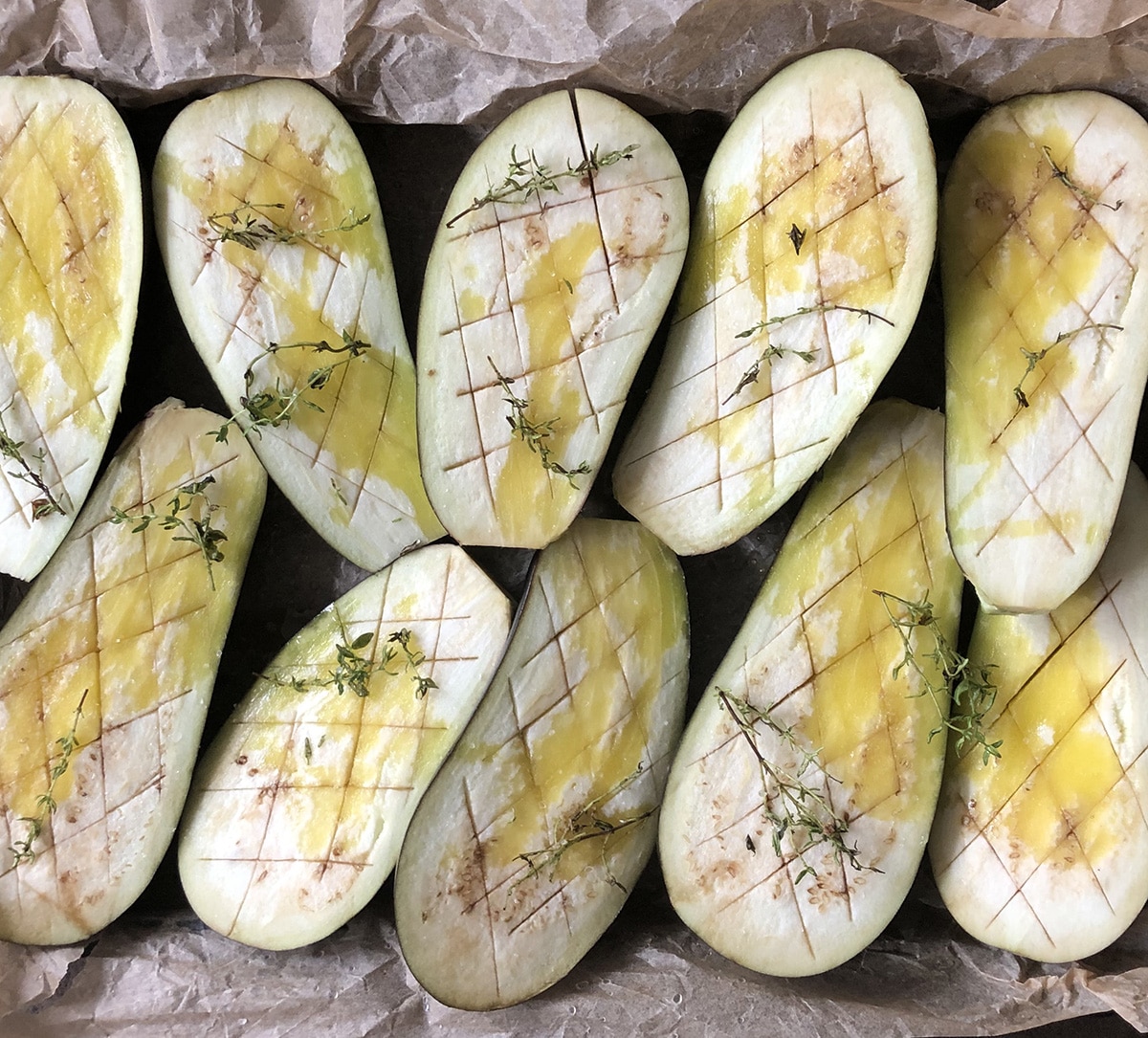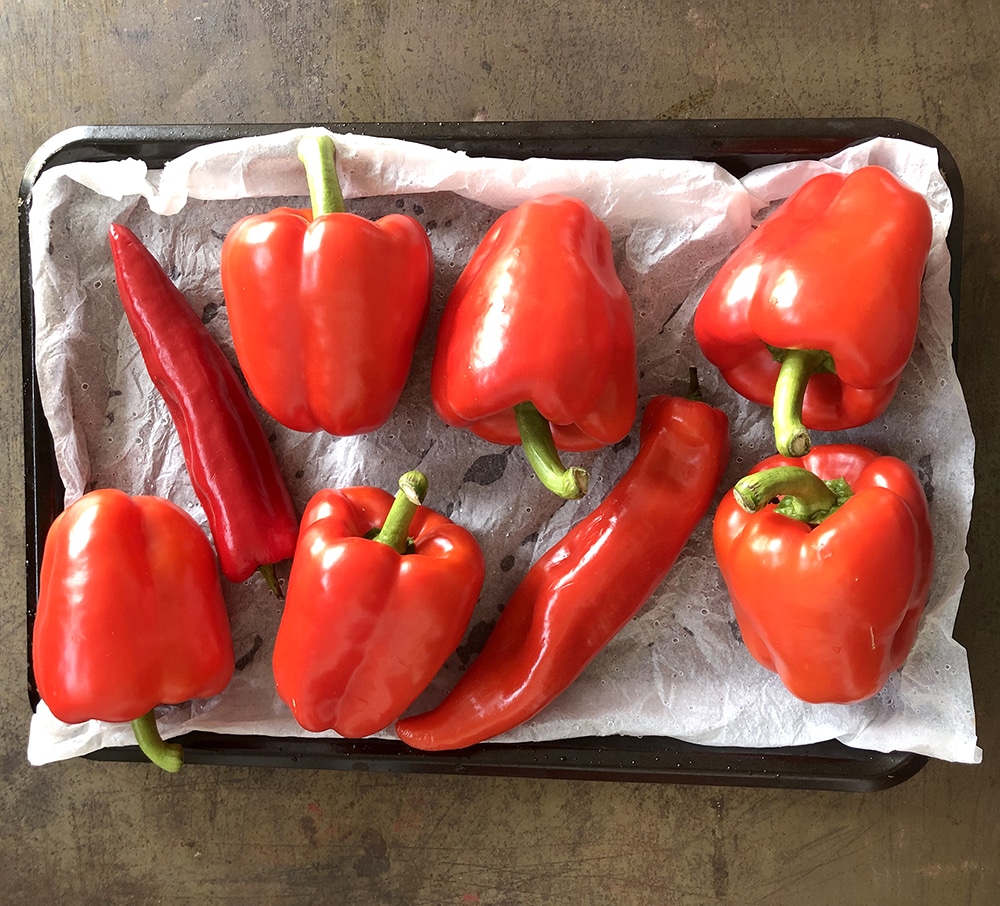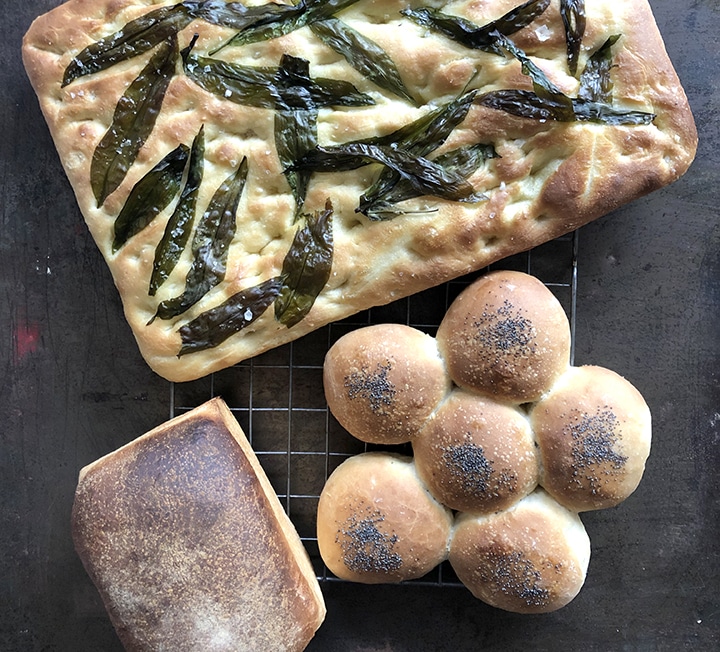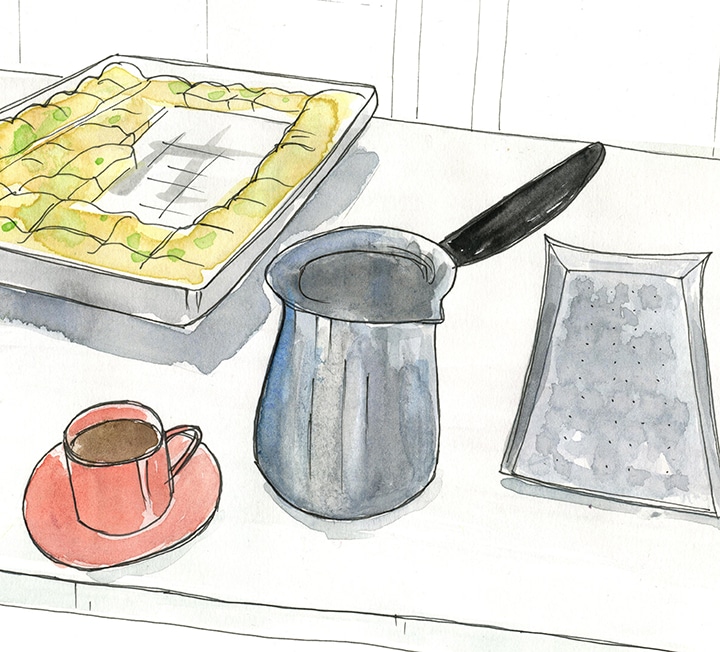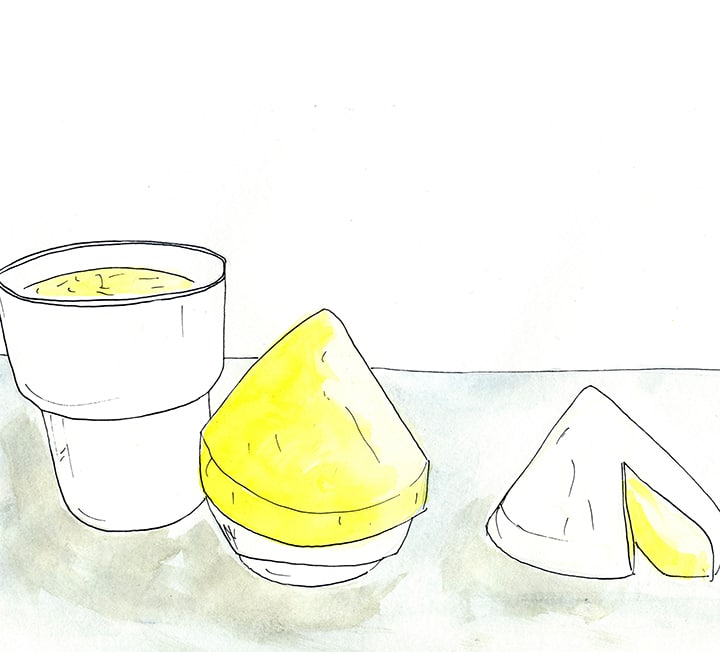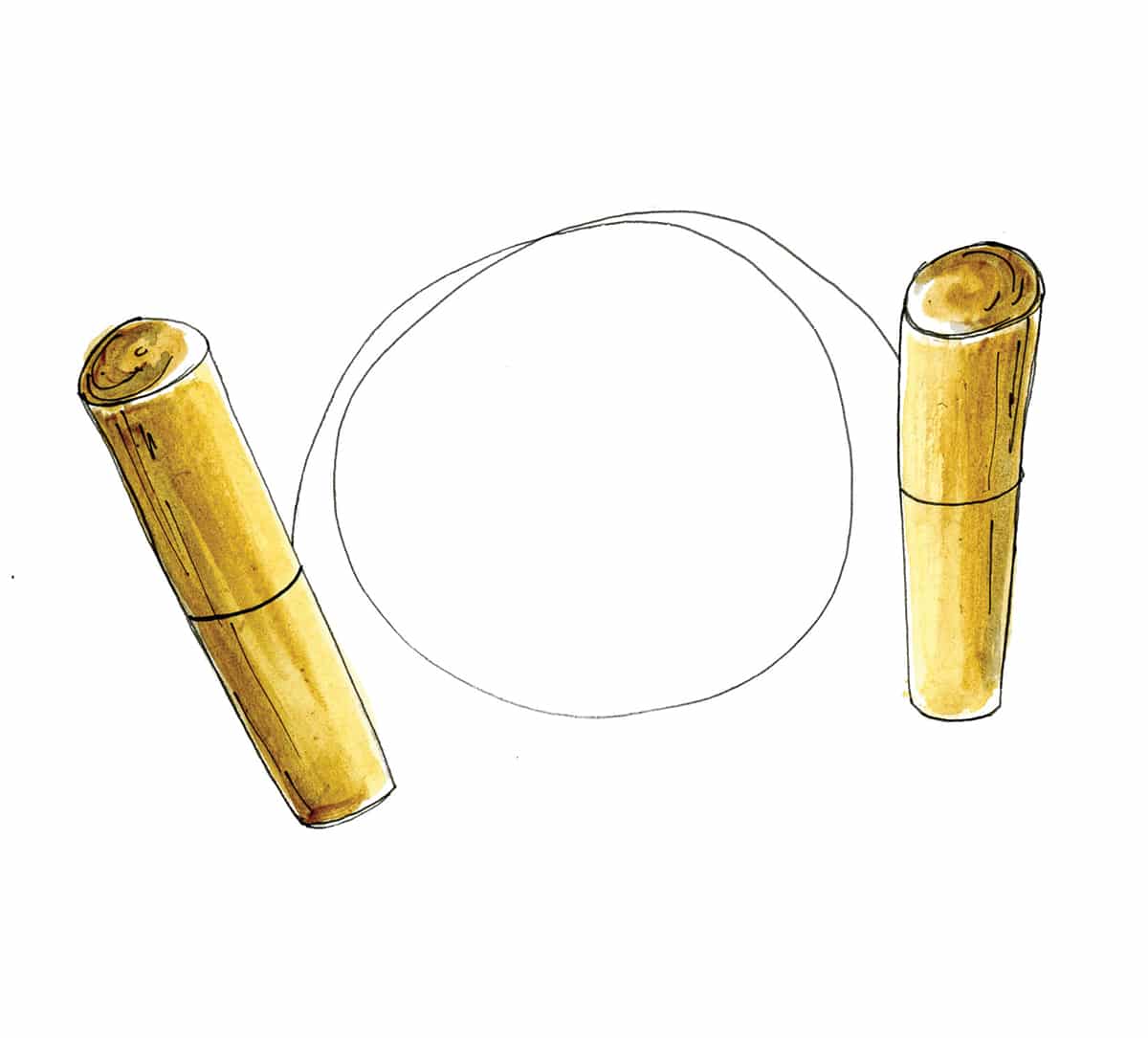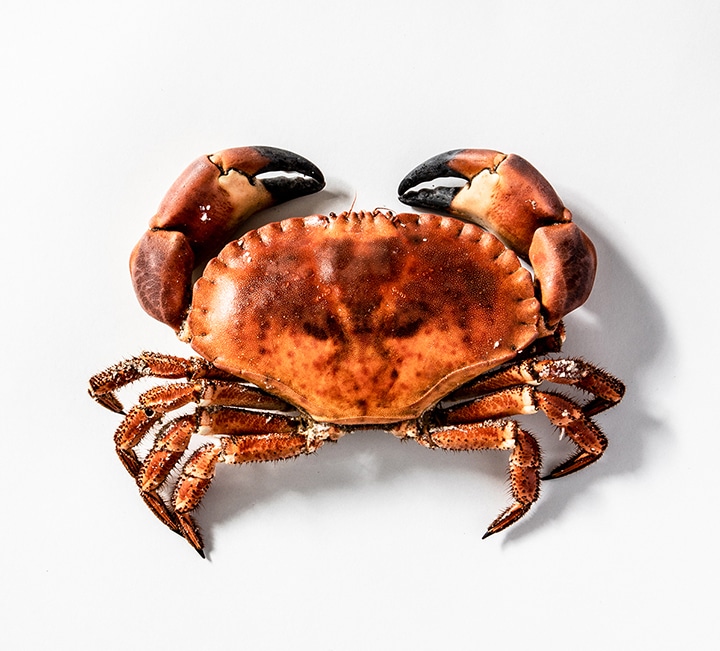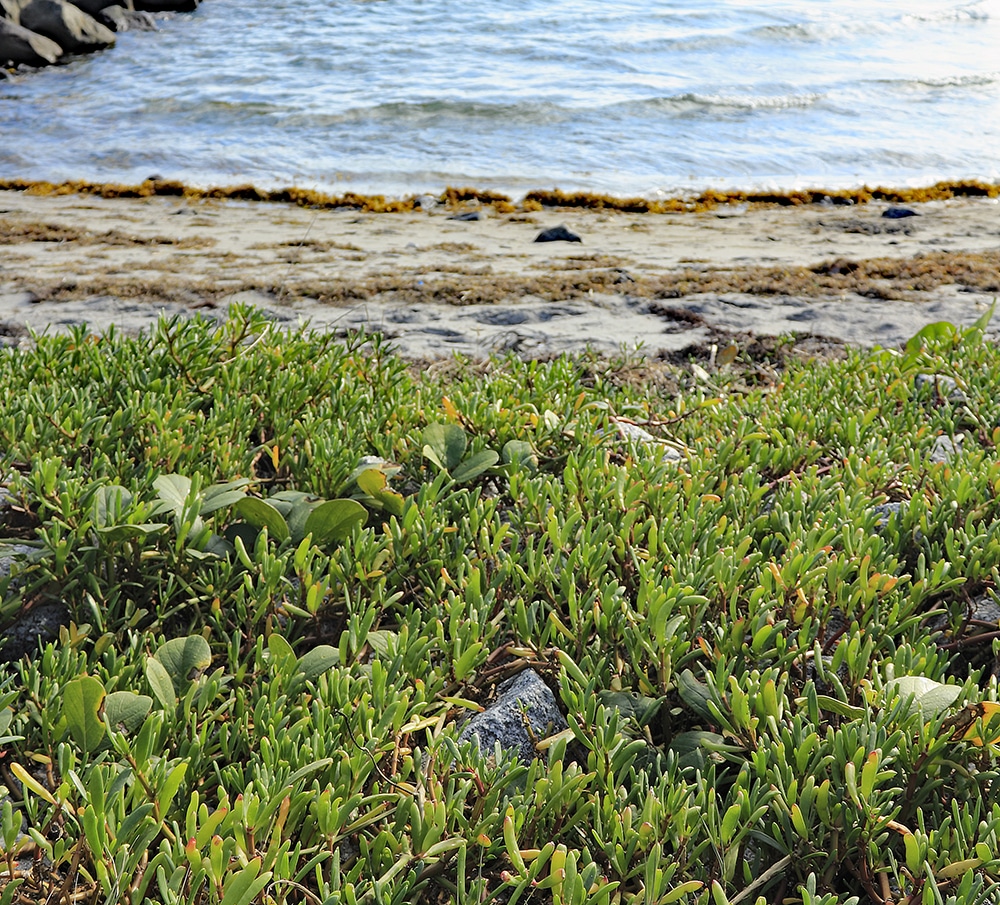Blessed are the cheesemakers: Mayfield
Clare Finney tells the story behind a smooth, almondy cow’s milk cheese from Alsop & Walker
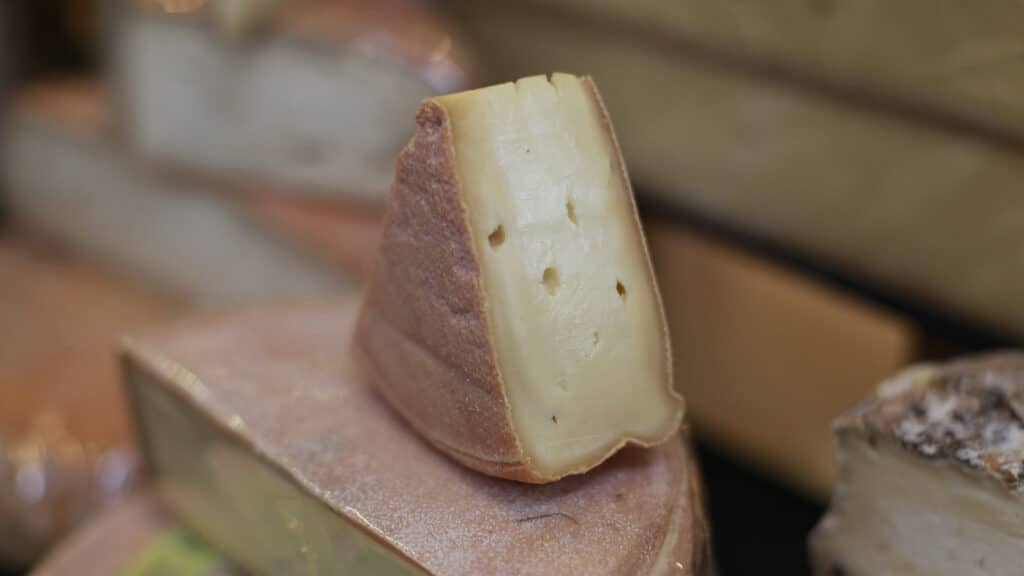

“WHEN THE STARS ALIGNED, THE RESULT WAS PURE ALCHEMY – A CHEESE WITH A CLEAN FINISH AND PLEASINGLY LARGE HOLES”
“Would you say it’s the British answer to emmental?” I suggest to Arthur Alsop, displaying what in hindsight was perhaps an overweening level of presumption, given the cheese at hand. Dubbed Mayfield in celebration of a local village in their home of East Sussex, the hard, holey cow’s milk number made by Arthur Alsop and Nic Walker has, in the past few years, won both public affection, and a fistful of gold and silver gongs.
In his reply, Arthur displays all the patience of an artisanal cheesemaker who spends most of his life waiting for wheels to mature in a cool room: “Not really. It very much stands by itself.” It might look like an emmental, in so far as it’s riddled with holes, hard and golden, but every cheese produced by Alsop & Walker is unique to the pair’s East Sussex cheesemaking. If you want emmental, head to Jumi round the corner. If you want Mayfield, you’re in the right place.
“We wanted a cheese with natural holes,” Arthur recalls of the brief they set themselves when he and Nic decided to add a new cheese to their collection. “There weren’t many in Britain, because it’s difficult: you’ve got to ensure the moisture, humidity and acidity levels are right,” he cautions.
Still, being naturally adventurous, they continued apace. Sometimes they’d get the holes, but the flavour would be all over the shop; other times, the reverse would occur. But when the stars aligned, the result was pure alchemy – a smooth, almondy cheese with a clean finish and large holes you can’t help but run your tongue over, as you feel the yielding creaminess of its hard-soft pate.
“It’s very easy going,” Arthur continues. Not one to be fussy, the whens and wheres and wherefores of Mayfield are what you make of them: “Breakfast, with bread, in a fondu or on a cheeseboard.”
Made every morning, from milk which has been delivered the previous night from small farms surrounding the cheesemaking rooms in Sussex, it reflects the seasons: now it’s lighter and creamier, because the cows are out to pasture: come winter, it will be buttery and creamy, as the cows’ diet changes. It’s enjoyable in every circumstance – though having now reappraised Mayfield’s considerable standing, I agree with Arthur: “I tend to have it just by itself.”
Blessed are the cheesemakers: Mayfield
Clare Finney tells the story behind a smooth, almondy cow’s milk cheese from Alsop & Walker


“ST NECTAIRE FERMIER TASTES LIKE AN ILLICIT TRYST ON A PILE OF HAY IN A HOT, STUFFY FARM BUILDING”
Image: Polly Webster
I once interviewed a man whose job it was to drive blood and organs between hospitals for potentially life-saving transplants. The gravity of his cargo weighed heavily upon him as he weaved through the lunatic traffic of central London, seeking to balance the competing demands of speed and meticulous care. Driving back from France, I knew how he felt.
It had been a holiday story familiar to most members of the British middle class. We’d been staying in a house in the Auvergne region of France, and on the first morning had been to the food market in the nearest small town, where a cheesemaker had set up a table piled high with St Nectaire fermier cheese – a washed rind beauty made from the unpasteurised milk of the Salers cows that feed on the region’s rich, volcanic pastures. With the deep fungal funk of its grey-blue rind playing off the nutty silk of its centre, it tasted a bit like wild mushrooms in a creamy sauce, eaten in a cellar. Or, if we’re going to be properly Gallic about it, like an illicit tryst on a pile of hay in a hot, stuffy farm building. As a cheese, it was the perfect complement to bread, wine and languor. So, of course, I impulsively bought several more to take home.
The only problem was that we were driving back. It was the middle of a very hot summer, and we had given ourselves a leisurely few days to make it home. And time, soft cheese and a hot car make for a messy ménage à trois. For three days, everything – our route, our timings, our personal comfort – became subservient to the needs of the cheese. To my horror, the two hotels we’d booked had no fridges in the rooms. In one, much to the misery of both my partner and the planet, I made the air conditioning as cold as possible and we slept in our clothes. In the other, there was no air con at all, so I ran a cold bath, and, using whatever came to hand, created a waterproof floating raft on which the precious cargo could sit.
About a week after making it home and gorging myself silly in a rush to finish the cheese before it died, I stumbled upon loads of St Nectaire fermier at Borough Market’s Une Normande a Londres, at least the equal of the stuff I’d bought in France, and considerably better for having at no stage spent three days in a hot car. Yes, the vital organs made it to the hospital, but apparently the patient didn’t need them after all.
Blessed are the cheesemakers: Mayfield
Clare Finney tells the story behind a smooth, almondy cow’s milk cheese from Alsop & Walker


“PIMENTÓN BECAME UBIQUITOUS IN SPANISH COOKING – FROM PAELLA, THROUGH PATATAS, CHORIZO, SOBRASADA AND FAR BEYOND”
If you see red in a dish, there’s a good chance it’s thanks to a sprinkle of paprika or cayenne – both of which are dried and ground derivatives of different types of capsicum peppers. Cayenne brings the heat (and is often mixed into paprika to give it a kick). Paprika is often sweet, but ultimately nuanced and varied.
Paprika
As Claudia Roden mentions in her book The Food of Spain, red pepper (and by extraction, paprika) is “the most loved and indispensable of Spanish flavourings”.
The capsicum family is not native to Spain – the seeds having originally been brought back from South America in the 16th century by Franciscan monks, and planted in their monasteries along the Camino de Santiago in northern Spain. Their fruits were soon used in fresh, dry and ground form across Spain, though vast pimentón mills, which produce the fine powder we know now, were more of a 19th century thing. From then (if not before), pimentón became ubiquitous in Spanish cooking – from paella, through patatas, chorizo, sobrasada and far beyond.
Paprika provides colour and flavour and there are four different types of Spanish paprika (known as pimentón): dulce (sweet and mild); agrodolce (bittersweet); picante (hot) and ahumado (smoked). The level of sweet, hot or bitter depends on the specific variety of capsicum being used, though it’s fair to say that it’s always intense and, err, peppery. Any smokiness comes from having been wood-smoked, rather than air-dried.
Different Spanish dishes require different varieties of pimentón, often depending on historic local usage. So when seeing paprika in a recipe, you should always check whether the author meant for it to be sweet, smoky or hot. Note, also, that if you’re after quality, then seek the DOP labelled pimentón de la Vera, which tends to have been smoke-dried, or the more orangey-red pimentón de Murcia, which are sun-dried and sweet.
This intoxicating red powder is not the sole preserve of the Spaniards, though. Hungary counts itself (rightly) as a significant producer and user of paprika. In fact, the British ‘paprika’ comes from the Slavic term for pepper, rather than the Spanish ‘pimentón’, so clearly while not as ancient as the Spanish, the central-eastern European influence over the British use of this spice must be strong.
As a general rule Hungarian paprika is air-dried and sweet, whereas Spanish pimentón tends to be the smoke-dried variety. However, neither country’s red spices are uniform, and happily both Spice Mountain and Brindisa have different grades and varieties, all clearly labelled to suit your requirements.
There’s good advice in the Brindisa cookbook/encyclopedia on both the storage of paprika and how to cook with it. Essentially, the key points are: don’t leave paprika in the back of your cupboard for too long as its aroma and indeed flavour will disappear – the smell “should always overwhelm your senses. If it is dusty or flat it has been sitting on a shelf for too long”; and in terms of cooking, “be careful not to overheat the spice when adding to hot oil as it burns easily and can turn bitter.”
For what it’s worth, 99 per cent of the time, I add paprika to a liquid (into a stock, stew base or sauce). This dissipates the flavour rapidly, and negates the risk of burning. Where that’s not the case (perhaps when slowly sautéing onions, peppers, garlic or all of the above), the heat is gentle and cooking fat and juices relatively plentiful.
Cayenne pepper
As with the peppers used to make paprika, cayenne is a cultivar of capsicum annuum. It’s just that this particular red pepper is a hot one: 30,000-50,000 SHU on the Scoville scale, to be precise. This makes it similar in strength to a tabasco pepper, more than an aleppo pepper or chile de arbor (10,000-30,000 SHU), and less than a habanero or scotch bonnet (100,000-350,000 SHU).
Also, as with paprika, to create the spice, the red chilli fruits, named after the capital of French Guiana, are dried and ground into a powder, or sometimes left coarser, like flakes.
The geographical reference in the name is also an indication that cayenne peppers were originally from the New World, and still tend to prefer warm, subtropical and tropical climates.
Cayenne seems to stand up to hot oil a bit better than paprika, though is still liable to burn and turn acrid, so take care. Take care, too, with quantity: paprika can be generously teaspooned. Cayenne is better suited to a pinch.
Like paprika, you need to keep ground powder in an airtight container, and use before the aroma fades.
Culinary uses
Paprika is often paired with pork, whether in sausages, stews, or sauces. Its sweetness (or sweet and smokiness, where relevant) is also a fine match for eggs, potatoes, tomatoes, or even as another layer of pepperiness for bell or romano peppers.
Other proteins suited to this paprika are chicken, squid, octopus and shellfish – their relative blandness (compared to beef and lamb) are all enhanced by it, without being dominated.
Paprika is, as mentioned, ubiquitous in both Spanish and Hungarian cuisines. There are perhaps too many Spanish dishes that make use of paprika to single out any one of them, but it’s definitely appropriate to whet you whistle with a few of the Hungarian classics: goulash (a rich, meaty, medieval stew); and chicken paprikash, in which the meat simmers in a sauce that begins with a paprika-infused roux.
The Russian dish beef stroganoff is worth mentioning too. Here paprika, sour cream and sautéed beef tend to feature, and then any of mustard, pickles, white wine, brandy, onions and mushrooms find a place too, depending whose instructions you follow.
Cayenne is hot, so it tends to be sprinkled as an additional flourish to a dish, rather than appear as a dominant flavour. It’s also frequently used in spice blends and hot sauces.
This spice is now a global one, and it certainly features in Indian dishes and British ones (devilled kidneys, for example, and often very savoury things involving sharp cheeses, like breads, scones and rarebit).
But cayenne is most notably employed in the cuisines of the Caribbean, from whence it came: of the islands, of Mexico, and of Cajun and Creole cooking in the Deep South of America, whether that’s as a simple seasoning for corn, in addition to lime and butter, or as a kick in gumbo, jambalaya, or the batter mix for deep fried chicken (though apparently the Colonel’s includes paprika, black and white pepper and dried mustard, but not cayenne).
In need of a twist? Perhaps because there’s a natural sweetness to cayenne, it’s sometimes used as a chilli kick to coffee or chocolate desserts, and to cocktails too. Think chocolate pots and bloody marys.
Market spice heroes
I think it’s worth giving a shout out to all the chorizo-style sausages at the Market. There are so many different types of this Spanish sausage: cured, semi-cured, and not cured at all, with multiple regional variations across the country; the one thing uniting them being paprika.
Of course, there are proper Spanish chorizos at Borough, not least in Brindisa’s shop, where fantastic cured and deservedly famous semi-cured cooking sausages stand out. But you’ll also find paprika-fired fresh sausages at Ginger Pig and the large Balkan version of chorizo at Taste Croatia – all of which demonstrate that, as noted above, pork and paprika are a match made in heaven.
Specific recipes to look out for
Paprika and cayenne sit as highly effective seasonings in multiple recipes. However, on occasion, they’re essential and flavour-defining. For example, in:
— A Georgian plum chutney in Olia Hercules’ Mamushka, which requires a fair hit of smoked paprika.
— Claudia Roden’s mojo picon (spicy red sauce) is a mix of cayenne pepper, sweet paprika, cumin, garlic, olive oil and vinegar, and is used to enliven a number of dishes in her seminal book the Food of Spain.
— Monika Linton’s bible Brindisa is rouged with paprika. From simple paprika tumbled potatoes with lardons (you could add a pinch of cayenne to provide a kick), through octopus Galician-style, fried squid with paprika, and rice with chicken, rabbit and paprika – there are many options here.
— Brad McDonald’s book Deep South; New Southern Cooking is loaded with cayenne pepper, not least in his version of the Creole sausage, andouille.
— For devilled kidneys, look no further than Fergus Henderson’s Nose to Tail Eating.
See Ed’s Portuguese-inspired recipe for paprika pork collar and clams.
Blessed are the cheesemakers: Mayfield
Clare Finney tells the story behind a smooth, almondy cow’s milk cheese from Alsop & Walker


“THESE SPICES ARE BRUISERS – THE KIND OF AROMATICS THAT SHOULD BE USED JUDICIOUSLY AND IN RELATIVELY SMALL DOSES”
Fenugreek and mustard are distinctive and potent. They are the seeds of unassuming staple crops, yet as spices they are bruisers – the kind of aromatic that should be used judiciously and in relatively small doses. But as with any bully, underneath the tough guy exterior, there’s actually a lot to love.
Fenugreek
The fenugreek plant grows as a wheat-like staple crop in India (mostly in Rajasthan), across the Indian subcontinent and also in the Middle East. The crop is largely cultivated for animal feed, though its seeds and fragrant leaves have important culinary uses too. In this piece, we focus on the yellow, cuboid, stone-like seeds, which cross bitter tones with maple sweetness and, ultimately, a strong and persistent hint of generic curry powder – it’s often the main ingredient in that mix.
Though a key spice in Indian cuisine, fenugreek is now overshadowed in British-Indian domestic cooking by the likes of cumin, coriander, fennel seeds and turmeric. This may be due to the hardness of those seeds, which makes the spice seem a little inaccessible to the uninitiated, and recipe writers are perhaps reluctant to complicate their instructions; relative to the easy crack of a coriander seed, for example, fenugreek seeds appear near impossible to break down by pestle and mortar or domestic spice grinder.
In fact, the seeds are most easily used once they have been soaked for 8-12 hours, to both take the edge off their bitterness, and to soften them enough that they can be mashed into a paste.
It is possible to buy the spice in ground powder form, though again it seems less popular than cumin, coriander and turmeric in western recipes, perhaps on account of that dominant curry house undertone.
Meera Sodha writes in Made in India that fenugreek seeds have “a shockingly bitter aftertaste, which means they should never be used on their own, only among other robust flavours and in small quantities”. She also notes that as well as being soaked and mashed, the seeds can be thrown whole into hot oil at the beginning of a cooking process, along with the likes of mustard seeds.
The whole seeds last longer than most if kept in an air-tight container, though I’d argue if you hold on to a small quantity of any spice for longer than a year, then for the sake of your store cupboard admin, perhaps you should try to incorporate it more often. The powdered form is best used within a few months.
Mustard seeds
Mustard is grown in temperate regions in Pakistan, India, Nepal, Russia, Canada, the United States and of course over here in the UK (mostly in Norfolk). The green leaves can be eaten like a brassica (kale, cabbage, collard greens), and the crop is a major source of oil, similar to rapeseed. But mustard is best known as a spice, thanks to the little balls of flavour that are its seeds. Dried and stored in a jar they smell of very little, but crushed and mixed with water or vinegar, or tempered in hot oil, mustard will strip the hairs from your nostrils. This is due to a chemical reaction that takes place to produce the flavour compound allyl isothiocyanate, which is also released when crushing or grating horseradish and wasabi.
There are three main types of mustard seed: white (also known as yellow), brown and black. Broadly speaking, the white variety is sweeter and mellower (though still pungent), the black is hot, and the brown variety sits somewhere in the middle.
The black variety is particularly common in Indian cooking, but all three are used in different proportions across the mustard paste condiments that we know and love (or hate). Dijon mustard, for example, uses the brown variety (whole), Bordeaux comprises whole black and brown seeds, German mustard the black seeds, and depending where you look for information, English is a mix of brown and white mustard powder (Elizabeth David), or ground black mustard seeds with a sprinkle of ground white (Colmans).
Ground mustard powder (sometimes referred to as mustard ‘flour’) loses potency over time if left in a jar, but also once it’s mixed in water. The seeds, however, are good for at least a year in an air-tight jar.
Flavour pairings
It’s hard to think of a classic flavour pairing for fenugreek; this spice is rarely used on its own. Rather than pick out proteins, vegetables and pulses, then, it’s worth noting that fenugreek’s bitter-maple curry notes are well matched with other strong spices such as cumin and coriander. And in Indian cooking in particular, those mixes are often the dominant flavouring of dishes involving paneer or lentils.
Mustard, on the other hand, immediately invokes beef, pork and chicken. Across a variety of cuisines, these three meats are matched with mustard – whether in whole seed, ground or condiment form. The spice is also an excellent partner for roots like potatoes, celeriac and turnip, and brassicas such as kohlrabi, kale and cabbage. And we shouldn’t forget rabbit – so many of the rabbit recipes out there involve wholegrain mustard.
Cuisines and dishes
As mentioned, fenugreek is commonly used in Indian dishes, as a dominant flavouring in revitalising dals and across masala mixes. The seeds are used in the mix panch phoran, in equal parts alongside fennel, nigella, cumin and black mustard. These are all left whole and tempered in hot oil, before being used to flavour meats, vegetables and stews.
Fenugreek seeds are not, however, restricted to the Indian sub-continent. When ground, they are a major part of the spice rub çemen, which is used as a marinade for the Turkish cured and air-dried beef, pastirma.
And in the Middle East, fenugreek is known as hilbeh, and used (among other things) to make a dip or condiment of the same name. I tried this for the first time in a Lebanese café in Tel Aviv, and was hooked on first dip.
There are numerous recipes in circulation for Bengali mustard chicken (shorshe murgi), where of course the mustard is dominant and adds its own heat to that of fresh chilli.
In French cooking, dishes like celeriac remoulade make use of mustard paste. But it’s often a condiment matched with pork; whether in chop form, or more likely sausage (including acting as a foil to stinky andouillette). The same is true in Germany – is a plate of wurst and sauerkraut complete without a dollop of mustard?
Head north to Scandinavia, and mustard seems creamier and lighter even than that of Dijon (and certainly lurid yellow English). It’s often used in a sauce to cut through pickled herrings.
Specific recipes to look out for
Recipes that make the most of mustard and fenugreek spices include:
— Meera Sodha’s asparagus and peas in a Bengali mustard sauce in Fresh India is an excellent way of mixing Indian flavours with British spring/summer ingredients.
— I like the idea of Atul Kochar’s mustard and yoghurt chutney in his restaurant cooking book Benares. Black mustard seeds are tempered with hot oil until they crackle and pop, then mixed into a yoghurt flavoured with mint, ginger and honey. Excellent with seafood, vegetable fritters and bhajis, apparently.
— For French, why not try Raymond Blanc’s mustard braised rabbit in Kitchen Secrets?
— British chefs cooking with mustard (admittedly in French style) can’t look past Simon Hopkinson’s mustard and tarragon butter to go with steak, found within Week In, Week Out.
— Fenugreek recipes are harder to find. Why not try my version of hilbeh? I found it excellent alongside an omelette filled flatbread.
Market spice heroes
It would be remiss to write of mustard and not mention Fitz Fine Foods, who carry a wide range of mustards, many of them uniquely flavoured – think black olive, balsamic vinegar, cassis and truffle. They stock the range of classic French mustard pastes too.
See Ed’s recipe for the fenugreek-laced Middle Eastern dip hilbeh.
Crisp-skinned fish, barbecued lamb, cheese & crackers
Shaun Johnson, Borough’s Head of Development, on the ingredients of a perfect summer
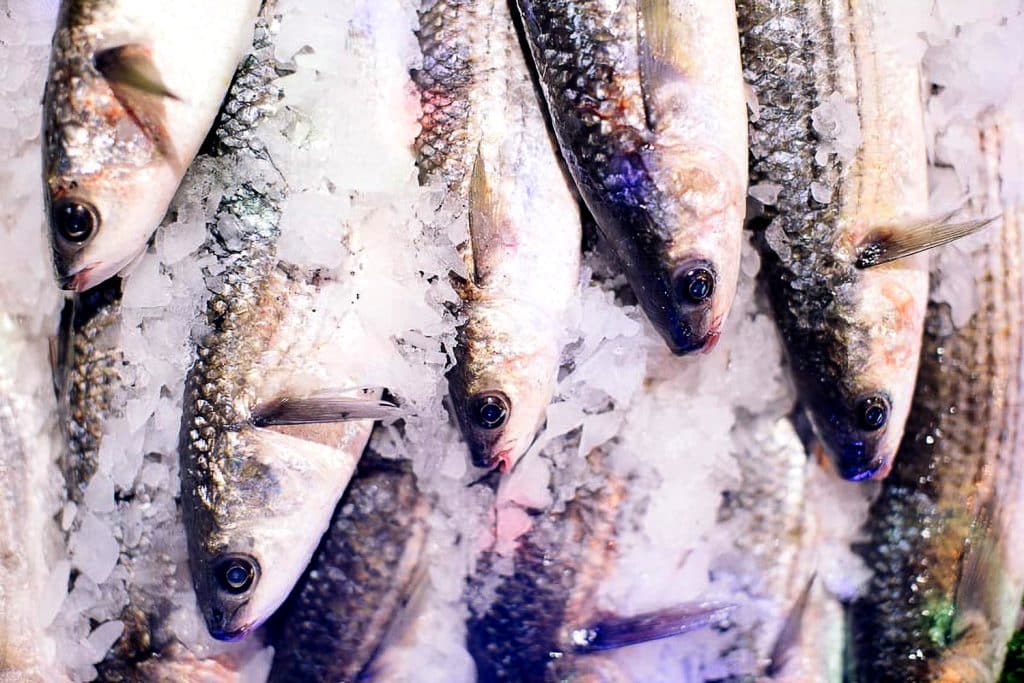

“BECAUSE OF MY HOSPITALITY BACKGROUND, I TEND TO GO INTO HOST MODE AT EVENTS AND BECOME UNPAID FRONT-OF-HOUSE”
Behind the scenes at Borough is a small team of dedicated professionals whose job it is to keep the wheels of this historic market turning. Most of them are completely obsessed with food, thanks in part to their daily exposure to exceptional produce and expert traders. We’ve asked them to share their thoughts on the ingredients and dishes that spark their excitement when summer rolls around.
Shaun Johnson is Borough’s Head of Development, responsible for embedding the trust’s policies and values into the daily experiences of customers and traders.
What item of summer produce do you most look forward to when the season rolls around?
My granddad was a fishmonger so unsurprisingly I’m a big fan of all kinds of fish, but particularly in the summer. Simply cooked white fish – hake or seabass perhaps – with a crispy skin, served with new potatoes and a salad, drizzled with chermoula is my favourite summer dish. I also love crab, which is beautiful in the summer months.

Tell us about the most memorable meal you’ve ever eaten on a summer holiday. Where was it and what was it?
When I was 19, I took a trip to the south of France with my partner at the time. We went for dinner at a pretty fancy place (for us!) in an old, converted monastery where we had chateaubriand. I had been working in an old-school restaurant where we cooked steak Diane at the table, and I remember how nice it felt to be on the other side, enjoying this wonderful French hospitality in a perfect setting.
It’s a perfect barbecue day. Are you the one firing up the barbecue or part of the crowd sitting with a cold drink while someone else sweats over the coals?
Because of my hospitality background, I tend to go into host mode at events and become unpaid front-of-house staff! I like to get ahead and help prep the sides and salads so everything is ready when it comes to grilling. And then I’m always on hand to keep people’s drinks topped up – a very important role, I believe.
What’s your ultimate barbecue dish, either for cooking or eating?
Lamb is my favourite meat and it’s perfect for the barbecue because of its higher fat content. I love cutlets or skewers marinated for hours in lots of herbs and garlic. Sides of choice include a cous cous salad packed with veggies and feta, corn on the cob and some salad leaves simply dressed with good quality olive oil and the white balsamic vinegar from The Olive Oil Co.
If you were planning your perfect picnic, what foods from Borough Market would you add to your basket?
I’m all about the snacks, so cheese and crackers are always a winner. I particularly love the young gorgonzola from either The Parma Ham & Mozzarella Stand or Gastronomica, crackers from Cracker Kitchen (available at Mons Cheesemongers). Gildas are also a perfect picnic food: little skewers with olives from Oliveology, anchovies from The Tinned Fish Market and a pickled jalapeño – the perfect bite. Extras would include some nuts from Food & Forest, a rosemary focaccia from Olivier’s Bakery, and some bresaola from Alpine Deli.
Where in London would you take your Borough Market picnic basket for an afternoon in the sun?
A perfect spot for a picnic and a walk is Banstead Woods. My partner also loves Brockwell Park so we go there a lot; the setting is perfect with its never-ending horizon. It’s gorgeous in the summer.
What’s your summer sundown tipple of choice? In an ideal world, where would you be sitting to enjoy it?
I like a really simple G&T – crisp and refreshing. I like lots of ice and a garnish of lime. Ideally, I’d be in Spain, Cadaqués to be exact. It’s a hidden gem on the Costa Brava with a beautiful harbour, reached by winding roads and not dominated by tourism. My happy place!
English cherries, Nicaraguan stew, barbecued chicken
Eden Connelly, Borough’s Administrative Assistant, on the ingredients of a perfect summer
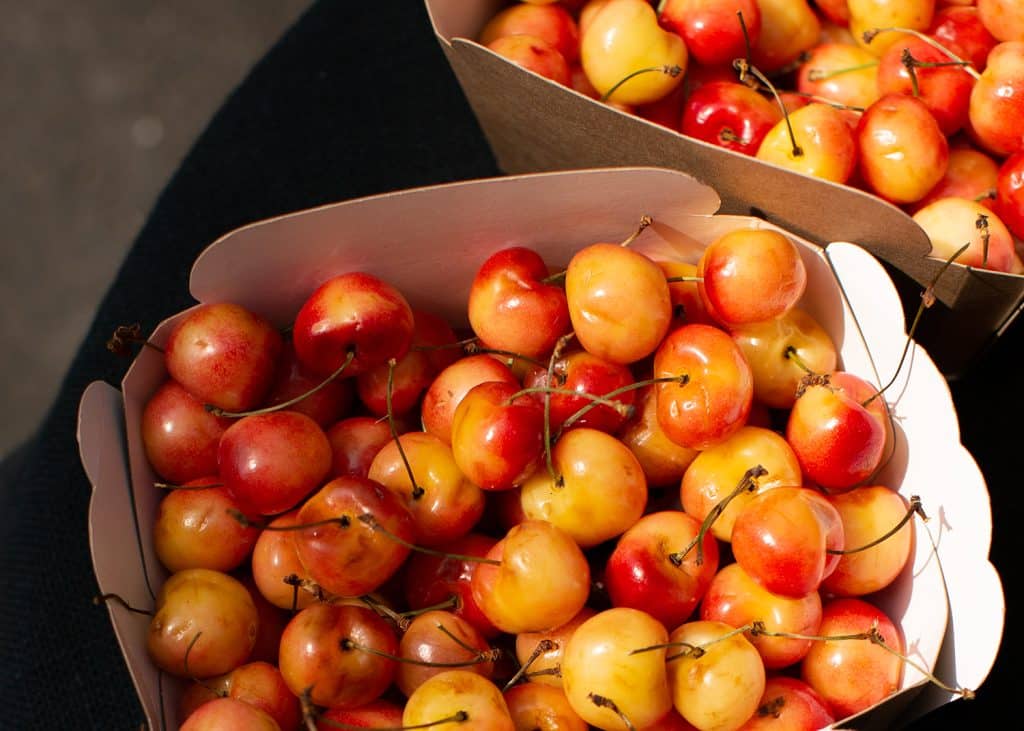

“AFTER A MONTH OF RICE AND BEANS, INDIO VIEJO SEEMED LIKE ONE OF THE MOST DELICIOUS THINGS I’D EVER EATEN”
Behind the scenes at Borough is a small team of dedicated professionals whose job it is to keep the wheels of this historic market turning. Most of them are completely obsessed with food, thanks in part to their daily exposure to exceptional produce and expert traders. We’ve asked them to share their thoughts on the ingredients and dishes that spark their excitement when summer rolls around.
Eden Connelly is Borough’s Administrative Assistant, responsible for a wide range of back office tasks essential to the efficient running of the market.
What item of summer produce do you most look forward to when the season rolls around?
I love cherries – they’re so versatile and work in all kinds of summer dishes and drinks. There’s a Moroccan-inspired recipe I like to make, with heavily spiced slow-cooked chicken, rice and dried cherries, which I swap for fresh cherries when they’re in season. In terms of desserts, I love a cherry version of my mum’s strawberry cheesecake. It’s a simple white chocolate fresh cheesecake with a cherry and amaretto sauce poured over the top. Delicious.

Tell us about the most memorable meal you’ve ever eaten on a summer holiday. Where was it and what was it?
I discovered a dish in Nicaragua while I was volunteering for World Challenge, which was very tasty but seemed like one of the most delicious things I’d ever eaten after spending an entire month eating gallo pinto (rice and beans) with every meal. It’s called indio viejo and it’s a beef stew made with maize and shredded meats. It’s so filling and fairly cheap to make, and while not traditionally summery, it reminds me of that trip and all the great memories we made.
It’s a perfect barbecue day. Are you the one firing up the barbecue or part of the crowd sitting with a cold drink while someone else sweats over the coals?
I tend to be in charge of desserts and drinks (and the occasional salad!) at barbecues. I like to make pitchers of cocktails for ease at bigger gatherings. My signature drink is very pink – I love the flavour of berries, so I mix pink lemonade (my favourite for this is the cranberry lime lemonade from The French Comte) with fresh raspberries, lots of ice and either cherry or raspberry gin for the adults. And my go-to salad – because I love Middle Eastern flavours – is halloumi drizzled in hot honey (ideally raw chilli honey from From Field and Flower) on a pile of grains, pomegranate, cucumber and tomatoes, finished with coriander.
What’s your ultimate barbecue dish, either for cooking or eating?
My cousin’s husband is a chef and he makes an amazing marinated chicken for family barbecues. I don’t know the exact recipe, but he sections the whole bird before marinating it in a spicy, sweet combination of tomato and hot honey / chilli sauce (either the mango chilli sauce or naga chilli sauce from Wiltshire Chilli Farm would probably work well, dependent on the flavours of the rest of barbecue) and lots of spices.
If you were planning your perfect picnic, what foods from Borough Market would you add to your basket?
I love picky bits that don’t need any cutlery. Berries are always a winner and we have so much choice at the market. I love bread and tend to pick up a jar of really good pesto or salsa, like the green herb salsa from La Pepia, which you can dip or spread, negating the need for butter.
Where in London would you take your Borough Market picnic basket for an afternoon in the sun?
I have a few favourite places. One close by the market is Leathermarket Gardens. It’s a good spot for a picnic with some lovely greenery and flowers. Two of my other favourites are a bit further out but are well worth the journey. One is Richmond Park, which I love because of the potential to see the deer. I really enjoy being surrounding by wildlife. The other is Chiswick House and Gardens, which is stunning. The ambience is lovely and it’s perfect for a post-picnic walk.
What’s your summer sundown tipple of choice? In an ideal world, where would you be sitting to enjoy it?
Something citrussy is perfect for a really hot day. I like to mix limoncello and lemonade with a dash of bitters and blend with ice – super refreshing and cooling. I’d drink it sat in the garden with friends around the firepit with my dog Theo by our sides, blankets (if needed) and plenty of nibbles within easy reach.
Blessed are the cheesemakers: Mayfield
Clare Finney tells the story behind a smooth, almondy cow’s milk cheese from Alsop & Walker


“IF YOUR PULSES TAKE AN ABSOLUTE AGE TO COOK, THEY MAY HAVE BEEN LURKING RATHER TOO LONG IN THE CUPBOARD”
Cooking up a pot of pulses – in this case, chickpeas – is an absolute no-brainer if you’re wanting to get ahead with the building blocks for a few meals. And there’s the added bonus that any surplus pulses can be frozen in small quantities for quick fixes at a later date.
It’s a good idea to soak your chickpeas overnight if you remember: soaked pulses cook more quickly, soften more evenly and are more digestible than dried (once you’ve poured away the soaking liquid and started afresh). Don’t worry, all is not lost if you forget to soak before you go to bed – you can use the quick-soak method. Just cover the chickpeas with about 10cm water (they will eventually triple in size) and bring the pan up to the boil. Leave them to soak for 1 hour and then drain away the water.
Once ready to cook, pour the chickpeas into a large pan with some fresh water – I like to cover them by just about 5cm liquid at this stage so that the cooking stock is not too diluted, as I may use this starchy liquid (known as aquafaba) in another recipe. More on that later. Bring the pot up to the boil, cover, and then simmer for anything between 45 mins to 1 hour until cooked through, topping up with water if necessary, to keep the chickpeas submerged.
When preparing chickpeas specifically for hummus it’s worth continuing until their texture becomes really soft and creamy, if you want a silky-smooth result, but generally I prefer a slightly nutty bite. If your pulses take an absolute age to cook, they may have been lurking rather too long in the cupboard, but they will eventually soften up – just be patient. Adding half a teaspoon of baking soda is an option if your water is especially hard (it’s loaded with minerals such as magnesium and calcium, which strengthen the cell walls and hinder moisture absorption).
I tend to salt my chickpeas once cooked. It’s not that the salt will toughen your beans, that notion has been disproven, but I do sometimes use pulses in deserts and have no need for salt at all. Store the chickpeas in their own stock in a large pot in the fridge and use within five days.
How to use your cooked chickpeas
— Roast vegetables such as carrot, aubergine, red peppers, onions and potatoes with cumin, coriander and cinnamon, then add a spicy tomato sauce and chickpeas for the classic Turkish dish turlu turlu.
— Whizz up a simple hummus with garlic, extra virgin olive oil, tahini, lemon juice and seasoning. Jazz up the hummus by blitzing in roasted veg such as carrot, parsnip or beetroot, or inject some green with handfuls of fresh herbs.
— Add them to a bowl of long pasta such as linguine with plenty of extra virgin olive oil, lemon juice and zest, parsley, parmesan and black pepper.
— Fry chorizo with onion and then add a can of tomatoes and plenty of chickpeas for a super-quick supper. You could add spinach at the last minute, or even crack in a couple of eggs to poach/ steam in the pan with the lid on.
— A ladle of chickpeas will make any salad more substantial – perfect for lunch boxes.
— How about going Indian with a traditional chana chaat?
— Do try whisking up the aquafaba (the cooking water). You may have to boil the stock to reduce it down to a thick, gloopy, egg white consistency, but I usually find that it thickens up beautifully as the chickpeas sit in it in the fridge. The starchy stock will beat up to a frothy foam (admittedly it takes some serious beating – I’d definitely be thinking electric) which can be used as an egg replacer in meringues, cakes and even yorkshire pudding.
See Jenny’s recipe for chana chaat.
Blessed are the cheesemakers: Mayfield
Clare Finney tells the story behind a smooth, almondy cow’s milk cheese from Alsop & Walker


“I PERSONALLY THINK THIS IS A CRAFT THAT CAN’T BE LEARNED BY MOST PEOPLE – IT TAKES EXTREME DEXTERITY”
Interview & illustration: Ed Smith
The finest jamónes are those that fall under the four formally classified grades of jamón Ibérico, which is what we focus on at Brindisa. You’ll see a mass of legs hanging in our temperature-controlled chamber, with one or two of our skilled carvers each working on a leg throughout the day.
Jamón Ibérico is made from pigs that are native to the Iberian peninsula. Diet, breed and living conditions determine which grade of jamón their meat will be. Each leg that we import will have been aged between 18 months and four years. To do justice to the time, effort and knowledge needed to produce the meat, the carver has to be well skilled and have the best tools: a sharp, flexible knife, and a quality stand to hold the ham still.
The simplest and most traditional form of ham stand is basically just a clamp, which fixes a ham in place and allows you to carve without having to hold the meat steady. More sophisticated stands have an adjustable, rotating collar. This allows the carver to turn the ham through 360 degrees as they work, making both the preparation – trimming off the skin and fat – and the carving much easier. It allows the carver to be dexterous and skilled. It’s safer too, as they can always work at the optimum angle for their knife.
The stands we use at Borough Market also allow us to move the jamónes forward and back and from side to side, which means people of different heights can work in comfort. If they’re standing there for several hours, that’s really important.
It will take a skilled carver about two to two-and-a-half hours to carve a whole jamón. I personally think it’s a craft that can’t be learned by most – it takes extreme dexterity. And maybe there’s something of the art in it too. Certainly my Spanish colleagues think so – the best of them would say they feel a real connection with the meat.
Our guys are true experts. They carve the meat into beautifully thin slices and present them in intricate concentric circles while they work; it looks amazing and because it’s been sliced so skillfully, tastes incredible too. The better the meat is carved, the better it is to eat.
Blessed are the cheesemakers: Mayfield
Clare Finney tells the story behind a smooth, almondy cow’s milk cheese from Alsop & Walker


“THEY WASH THE CHEESES EVERY OTHER DAY FOR FOUR WEEKS, TURNING THEM FROM CREAMY WHITE TO SUNSET ORANGE”
It may be a small, unassuming rural village in Somerset, but Kelston – and the century-old dairy farm it is home to – has a couple of claims to fame. The first is as the home and burial place of Sir John Harington, godson of Queen Elizabeth I and inventor of the first flush toilet; the second is as the origin of a multiple award-winning range of cheeses.
Bath Soft Cheese is the name – both of the company and the eponymous cheese which was so renowned in the 18th and 19th centuries, it was recommended to Admiral Lord Nelson. The Padfield family have been making this and other cheeses here for four generations, so it comes as no surprise that they should want to reflect some of the area’s rich history in the cheeses.
One of the more recent additions to their stable is Merry Wyfe: a cider-washed version of their gouda-like, semi-hard cheese, Wyfe of Bath. Those familiar with Chaucer will recognise its name – so-called because the Padfields, the family behind the cheese, are a literary lot. “And, like the tale, when you cut into a Wyfe of Bath you will get a taste old England,” says Hugh Padfield. “It’s made in the same way farmers would have made simple cheeses with milk that wasn’t sold for drinking: by putting curds in a basket.”
“We’ve quite the team of cheesemakers here,” he continues, “and all of us like to experiment.” As a result, the number of test cheeses lurking around the ripening rooms had increased exponentially over the years. “One day I said to the staff, we need to be more focused – we need to decide on a new cheese and do it properly.”
After a heated tasting session, the team alighted upon the alluring pungency of a washed-rind cheese. “When you wash the rind, you aren’t washing off what is there. It’s about adding moisture and nutrients to the rind,” says Hugh patiently. It’s why washed-rind cheeses are so richly imbued with flavour: the washing encourages the growth of yeast and bacteria, lending the cheese its pungent smell and distinctive colour and texture.
Merry Wyfe was a while in the making: “We knew we wanted a washed-rind cheese, but wanted to experiment with the liquid,” he continues. “We are all about local provenance, so ideally we wanted to use something produced in the area.” In the end, the answer was on their doorstep: cider brewed by Hugh’s father, from the apples of the three ancient orchards on their farm. “Back in the day the apples would have been used to brew cider for local pubs, but they were just dropping to the floor and being eaten by the cows until dad started fermenting cider two or three years ago.” They had a few litres to work with “and we found it produced this beautiful colour and rich smell when combined with Wyfe of Bath.”
They wash the cheeses every other day for four weeks in the ripening room, transforming them from creamy white to sunset orange. “It’s very labour-intensive, but it tastes great,” Hugh continues. Merry Wyfe has even won a couple of awards, including Best Organic Cheese at the recent British Cheese Awards – “but what we’re most proud of is its consistency. Awards come and go, but it is something to build up regular customers for a consistently good cheese.”
The name also took some developing. “It was one of the farm workers that suggested Merry Wyfe – ‘the Wyfe of Bath has been soaked in cider, hasn’t she, so she’s tipsy,’ he pointed out.” At the same time, Hugh’s friend told him about Queen Elizabeth I’s visit to Kelston in the 16th century. “I thought we might be able to have an Elizabethan reference in the name of the cheese.”
Given the context, Shakespeare’s The Merry Wives of Windsor stuck out immediately. “I will rather trust a Fleming with my butter, Parson Hugh the Welshman with my cheese, an Irishman with my aqua vitae bottle, or a thief to walk my ambling gelding, than my wife with herself,” quotes Hugh, laughing. “It all tied together: the cider, Kelston village, our love of literature” – and, of course, their cheese.
Blessed are the cheesemakers: Mayfield
Clare Finney tells the story behind a smooth, almondy cow’s milk cheese from Alsop & Walker


“GENERATIONS OF BRITISH CHILDREN WERE ONCE GIVEN A SHRIMPING NET AS SOON AS THEY ARRIVED AT THE SEASIDE”
As the summer heat cranks up, Londoners often turn their thoughts to the seaside. Scrunched up and wilting in a sultry train, the idea of sauntering along a beach, exploring rock pools and dashing into the sea becomes irresistible. Most of us, however, cannot easily escape the city’s baking hot streets, so we have to find other ways of conjuring up the seashore.
Indulging in piles of some sweet-fleshed crustacean, such as tiny brown shrimp or succulent pink prawns, is a good start. Picnic on potted shrimp and crusty bread or kick off your shoes and dip some cold prawns into a pot of home-made mayonnaise as you sip a chilled beer or white wine – it will make your toes wriggle in delight. By setting their table by an open window and serving chilled gazpacho garnished with delicate ozone-flavoured langoustine, apartment-dwellers will be able to imagine a salty breeze drifting on the night air as the sea gulls swoop and cry from their London chimney pots.
Curiously, in our food-obsessed culture, few of us give much thought to the source of such delicacies as brown shrimp, prawns and langoustine. Yet, generations of British children were once given a shrimping net with their mandatory bucket and spade as soon as they arrived at the seaside. Countless happy hours were spent dipping it into rock pools trying to catch the colourless common prawn (Palaemon serratus), which would shoot away from the stealthy net.
During the summer months, this prawn can be found in great numbers inshore around the British Isles, although few are now sold in the UK. As winter approaches, they move out into deeper waters where they walk along the seabed in search of algae and other treats.
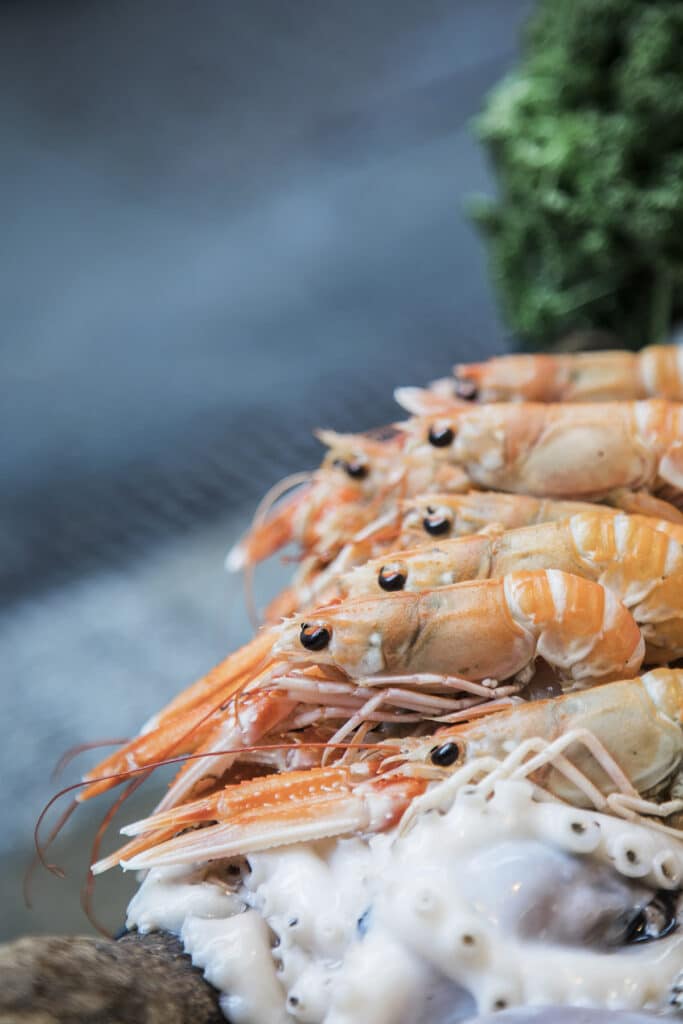
Most of the cooked prawns sold in Britain are Northern deep-water prawns (Pandalus borealis), which are caught in the icy waters of Norway, Greenland and North America. It is these that find themselves in sandwiches, classic prawn cocktails (best when the pink mayonnaise is seasoned with a dash of brandy) and simple rice salads, dressed with mayonnaise and chives and mixed with diced cucumber, radishes and fresh button mushrooms.
For many families, no trip to the seaside is complete without a quayside stroll to eat some scampi and chips. In reality, these cheeky little nuggets of pink-fleshed scampi are Nephrops norvegicus, known in more expensive restaurants by their French (as opposed to Italian) name of langoustine. These were once sold as Dublin Bay prawns or Norway lobsters and were discarded as a by-catch by British fisherman.
Langoustine belong to the lobster family and despite their pretty coral pink colour, live in muddy burrows, hunting for worms and small fish by night. They are found around the British Isles, although the majority are caught in Scottish waters, the finest being sustainably fished by creel, as opposed to the more destructive dredging. The creel baskets are left on the seabed for the langoustine to take up residence. They tend to be sold alive or very lightly blanched.
Their bodies have a delicate, sweet flavour that is gorgeous eaten cold with cucumber mayonnaise or tossed into the simplest of tomato sauces with pasta. Their shells make a superb seafood soup or broth.
Nor should Londoners forget crayfish – a form of fresh-water lobster that tastes equally exquisite. They are a summer delicacy and, should you buy signal crayfish (Pacifastacus leniusculus), you will also be helping keep down the numbers of this invasive and voracious American species in our rivers. They are particularly good plainly boiled and accompanied by beer and schnapps. Allow at least 500g per person, as most of the meat is in their tails.
For many years, another seaside indulgence was snacking on a bag of brown shrimp. In Jane Grigson’s Fish Book (1973), she recounts “a rare food pleasure I remember from the war years was walking along Morecambe Bay with my sister, each of us with a bag of shrimps. They were small and brown, the best kind. We chewed them without bothering to peel all of them. Something of their vivid sweetness came through in potted shrimps when they went on sale again as food became easier.”
Many cooks today might squeal at the thought that, as they splashed in the sea, they were literally stepping on the underwater world of Crangon crangon, otherwise known as the brown shrimp. During daylight hours, this small five to six centimetres-long, short-legged crustacean hides beneath the sand or mud to prevent discerning fish devouring it. Only one antenna betrays its presence. As darkness falls, it swims out in search of food, feasting on dead marine animals, organic matter, algae and fish eggs. Strange that such a useful waste disposer should taste so delicious.
Morecambe Bay remains a brown shrimp stronghold today, along with parts of the East Anglian and Welsh coasts. The shrimp are harvested from March until the first week in June and then again from September until the first week of December. All are quickly frozen, hence their sale throughout the year.
Traditionally, these were thought to be the sweetest of shrimps. They taste exquisite potted in spiced butter, eaten in sandwiches and turned into sauces to accompany white fish such as turbot, cod and brill. Twist off their heads and shells (reserving their flesh) and simmer briefly in water before liquidising and straining through muslin. This intensely flavoured liquid can then be whisked into a rich roux-based cream, marsala and tomato sauce. Add their flesh just before serving.
Today, we can eat prawns from around the world, as all are quickly frozen on harvesting, whether they’re farmed or wild. In Britain, large prawns tend to be favoured over small ones, making wild Madagascan prawns, red tiger prawns and wild black tiger prawns all popular.
However, it is the deep red cardinal or carabineros prawns (Plesiopenaeus edwardsianus) that are currently regarded as among the sweetest and most intense in flavour. Beloved in Spain and Portugal, they stretch across the east Atlantic from Portugal to South Africa. They are worth savouring plainly grilled with lemon, but can, of course, be added to risottos, paellas, pastas and seafood salads.
Truth be told, you will find escapist happiness in eating any type of crustacea – no matter where you happen to be at the time – they just taste so good!
